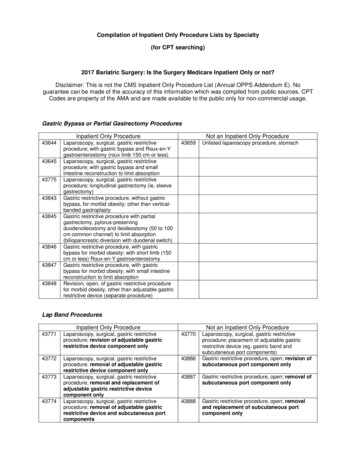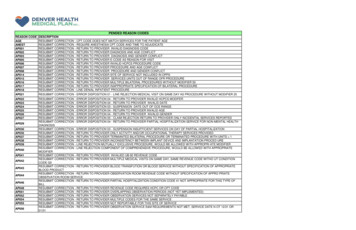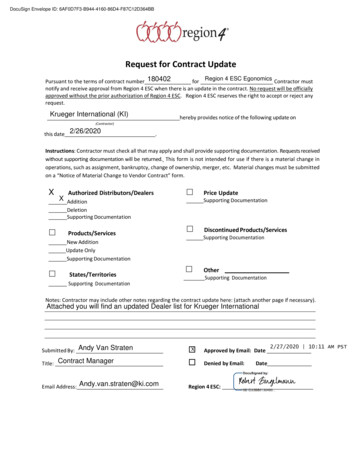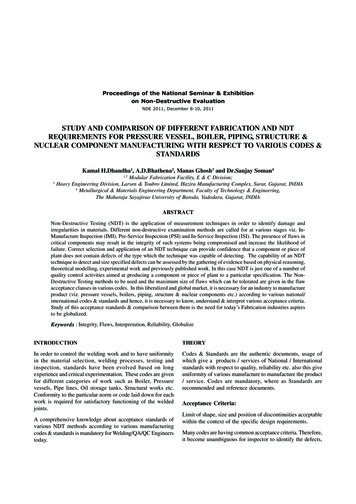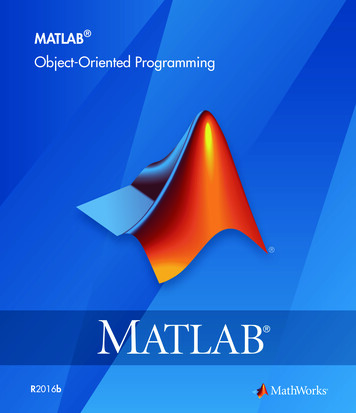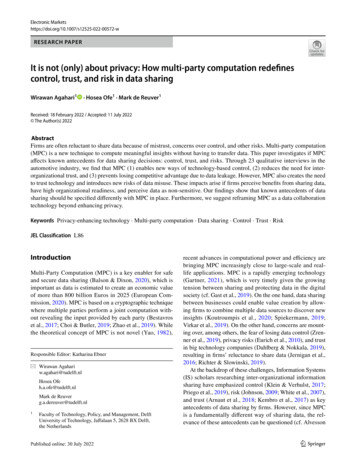
Transcription
Electronic ESEARCH PAPERIt is not (only) about privacy: How multi‑party computation redefinescontrol, trust, and risk in data sharingWirawan Agahari1· Hosea Ofe1 · Mark de Reuver1Received: 18 February 2022 / Accepted: 11 July 2022 The Author(s) 2022AbstractFirms are often reluctant to share data because of mistrust, concerns over control, and other risks. Multi-party computation(MPC) is a new technique to compute meaningful insights without having to transfer data. This paper investigates if MPCaffects known antecedents for data sharing decisions: control, trust, and risks. Through 23 qualitative interviews in theautomotive industry, we find that MPC (1) enables new ways of technology-based control, (2) reduces the need for interorganizational trust, and (3) prevents losing competitive advantage due to data leakage. However, MPC also creates the needto trust technology and introduces new risks of data misuse. These impacts arise if firms perceive benefits from sharing data,have high organizational readiness, and perceive data as non-sensitive. Our findings show that known antecedents of datasharing should be specified differently with MPC in place. Furthermore, we suggest reframing MPC as a data collaborationtechnology beyond enhancing privacy.Keywords Privacy-enhancing technology · Multi-party computation · Data sharing · Control · Trust · RiskJEL Classification L86IntroductionMulti-Party Computation (MPC) is a key enabler for safeand secure data sharing (Balson & Dixon, 2020), which isimportant as data is estimated to create an economic valueof more than 800 billion Euros in 2025 (European Commission, 2020). MPC is based on a cryptographic techniquewhere multiple parties perform a joint computation without revealing the input provided by each party (Bestavroset al., 2017; Choi & Butler, 2019; Zhao et al., 2019). Whilethe theoretical concept of MPC is not novel (Yao, 1982),Responsible Editor: Katharina Ebner* Wirawan Agahariw.agahari@tudelft.nlHosea Ofeh.a.ofe@tudelft.nlMark de Reuverg.a.dereuver@tudelft.nl1Faculty of Technology, Policy, and Management, DelftUniversity of Technology, Jaffalaan 5, 2628 BX Delft,the Netherlandsrecent advances in computational power and efficiency arebringing MPC increasingly close to large-scale and reallife applications. MPC is a rapidly emerging technology(Gartner, 2021), which is very timely given the growingtension between sharing and protecting data in the digitalsociety (cf. Gast et al., 2019). On the one hand, data sharingbetween businesses could enable value creation by allowing firms to combine multiple data sources to discover newinsights (Koutroumpis et al., 2020; Spiekermann, 2019;Virkar et al., 2019). On the other hand, concerns are mounting over, among others, the fear of losing data control (Zrenner et al., 2019), privacy risks (Eurich et al., 2010), and trustin big technology companies (Dahlberg & Nokkala, 2019),resulting in firms’ reluctance to share data (Jernigan et al.,2016; Richter & Slowinski, 2019).At the backdrop of these challenges, Information Systems(IS) scholars researching inter-organizational informationsharing have emphasized control (Klein & Verhulst, 2017;Priego et al., 2019), risk (Johnson, 2009; White et al., 2007),and trust (Arnaut et al., 2018; Kembro et al., 2017) as keyantecedents of data sharing by firms. However, since MPCis a fundamentally different way of sharing data, the relevance of these antecedents can be questioned (cf. Alvesson13Vol.:(0123456789)
W. Agahari et al.& Sandberg, 2011). On the one hand, MPC enables computational analysis without revealing input data (Bestavroset al., 2017; Choi & Butler, 2019; Zhao et al., 2019), eliminating the need for a trusted third party as an intermediarythat facilitates data sharing (Bruun et al., 2020; Helminger& Rechberger, 2022). Hence, firms should be able to retaindata control and possibly reduce the risk of data sharingin the process. On the other hand, MPC is not yet widelyapplied due to limitations of computational efficiency. As aresult, MPC could create new sources of control, new formsof trust, and new types of risk that were not known in existing data sharing approaches. As MPC is emerging in themarket (Gartner, 2021), it is important for scholars studyingdata sharing to understand if and under which conditionsexisting antecedents are no longer relevant or need to bespecified in new ways (cf. Gkeredakis & Constantinides,2019).This paper aims to investigate the impact of MPC onperceived control, trust, and perceived risks in the contextof data sharing by firms, in order to understand how MPCaffects known antecedents of firms’ data sharing decisions.To gain an in-depth understanding, we opt for a qualitativeapproach by conducting semi-structured interviews withexperts and practitioners. Then, we establish a set of propositions on the impact of MPC on perceived control, trust,and perceived risk and conditions under which the impactof MPC is deemed relevant. We select a study setting witha high level of risks and need for control, and a low level oftrust. We choose a data marketplace setting: a platform tofacilitate data sharing and trading between businesses withno prior relationship (Abbas et al., 2021). Since participantsin a data marketplace have no prior relationship, they face alack of inter-organizational trust and control over data (M.Spiekermann, 2019). We specifically focus on data marketplaces in the automotive industry, where key actors likeoriginal equipment manufacturers (OEMs) are mindful ofretaining control over sensitive data (Docherty et al., 2018;Kerber, 2018).Based on the research objective and setting, the researchquestion for this paper is: What are the impacts of multiparty computation (MPC) on perceived control, trust,and perceived risks in data sharing by firms through datamarketplaces?Our primary contribution is to the literature on businessto-business data sharing. This study is among the first toshow that MPC challenges what we know about the keyantecedents of data sharing decisions: perceived control,trust, and perceived risks. We develop an understanding ofhow known data sharing antecedents change or even becomeobsolete with MPC in place. In other words, we set a basisto extend existing theory on data sharing antecedents to theemerging context of MPC. Our secondary contribution is tothe MPC literature by being among the first to explore the13business impact of MPC beyond citizen privacy. In this way,we expand the understanding of the socio-economic aspectsof MPC, which are overlooked in the MPC literature (Agahari et al., 2021; Agrawal et al., 2021; Bruun et al., 2020;Kanger & Pruulmann-Vengerfeldt, 2015).BackgroundMulti‑party computation (MPC)MPC is a cryptographic technique where two or more parties perform a joint computation that results in a meaningful output without disclosing the input provided by eitherparty (Bestavros et al., 2017; Choi & Butler, 2019; Zhaoet al., 2019). MPC primarily relies on the secret-sharingprotocol, which is efficient and allows the participation ofmore parties in the computation (Shamir, 1979). Based onthis protocol, each party splits its input data into multipleencoded parts called secret shares, which are then computedand recombined to generate the final output. In this way,input data can be computed without revealing any information about it. A popular illustration of MPC is the millionaire’s problem (Yao, 1986), a secure comparison functionto determine which one of two millionaires is the richestwithout revealing the net worth to each other. Besides MPC,other technologies also share similar characteristics in enabling privacy-preserving computation (Agrawal et al., 2021),like homomorphic encryption (Gentry, 2009; Naehrig et al.,2011) and differential privacy (Dwork, 2006; Dwork & Roth,2014). However, according to Apfelbeck (2018), these technologies differ because MPC requires multiple data owners to perform computation, while only one data owner isneeded in homomorphic encryption. Moreover, unlike MPC,which uses encryption, differential privacy protects the databy adding random noise during the analysis. Nevertheless,those technologies can complement each other to implementrobust security requirements in various use cases (e.g., Alteret al., 2018; Pettai & Laud, 2015; Zhong et al., 2020).While the theoretical foundation of MPC has been aroundfor some time (Yao, 1982), recent advances in computationalpower and efficiency are making it closer to implementingMPC in real-life applications. Now, MPC can be deployed invarious contexts of use-cases: between companies within thesame domain (e.g., assessing common customers betweenorganizations for marketing purposes), across other unitswithin the same company (e.g., cross-selling), and acrosssupply chain tiers (e.g., streamlining manufacturer-supplierin supply chains). Examples include auction-based pricing (Bogetoft et al., 2009), tax fraud detection (Bogdanovet al., 2015), satellite collision prevention (Hemenway et al.,2016), and identifying the gender wage gap (Lapets et al.,2018). There are also some attempts to explore how MPC
It is not (only) about privacy: How multi‑party computation redefines control, trust, and risk can be implemented in data marketplaces. For instance, Garrido et al. (2021) conducted a systematic review to understand the landscape of MPC, homomorphic encryption, anddifferential privacy within the context of an IoT data market.Moreover, Roman and Vu (2019) combined MPC and smartcontracts to propose a data marketplaces architecture. Inaddition, Koch et al. (2021) used MPC to offer privacy-preserving distributed analytics in personal data marketplaces.Despite its potential, various barriers hinder MPC adoption by businesses. First, MPC still suffers from performancelimitations and scalability issues (Choi & Butler, 2019). Thislow maturity could result in unclear economic risks and highadoption costs for businesses (Zöll et al., 2021). Second,MPC is deemed highly complex to understand by nonexperts, making it difficult for prospective users to be awareof what MPC is capable of (Choi & Butler, 2019; Kanger &Pruulmann-Vengerfeldt, 2015). Third, regulations still tendto discourage data collaboration initiatives and are yet toclearly describe the position of MPC in light of data protection regulations (Choi & Butler, 2019; Zöll et al., 2021).Nevertheless, much of the discussion on MPC has beenfocusing on technical aspects, particularly improving itsefficiency and scalability. Only a small amount of researchfocused on socio-economic perspectives beyond technical aspects of MPC. For instance, Kanger and PruulmannVengerfeldt (2015) investigated the conditions for MPCadoption and found that MPC developers should focus onits usefulness and finding a target group that needs the technology. Meanwhile, Agahari et al. (2021) found that MPCcould enable data marketplaces to employ a “privacy-as-aservice” business model. Moreover, Agrawal et al. (2021)interviewed MPC experts and practitioners to explore designand governance challenges in developing MPC. They arguedthat future development of MPC should consider issues likeexplainability, usability, and accountability, in order to promote its adoption. Similarly, Bruun et al. (2020) argued thatwhile MPC offers “trustless trust” that eliminates the needfor intermediaries, it raises accountability issues due to theinability to link the results and the original input data. Furthermore, from the legal perspective, Helminger and Rechberger (2022) found that companies using MPC could comply with the General Data Protection Regulation (GDPR)while benefiting from the privacy-preserving computation.How MPC is used in data sharing: an illustrationTo illustrate how MPC is used in data sharing, particularlyin data marketplaces, we developed a hypothetical scenarioin the automotive industry (see Fig. 1). This scenario wasdeveloped based on prior studies (Bestavros et al., 2017;Bogdanov et al., 2015; Bogetoft et al., 2009; Roseman Labs,2022) and also used to help with the data collection process in this study (see “interview procedures and questions”section). In this use case, we consider an example wherethree car manufacturers want to monetize their car performance data. One possible option would be through datamarketplaces to facilitate matchmaking and data exchangebetween data owners (i.e., car manufacturers) and data users(i.e., automotive suppliers). However, this option requiresdata owners to transfer data to data marketplace operatorsand data users, meaning that other parties can have accessto complete datasets during the exchange. As a result, dataowners might find it difficult to control what data users willdo with the data. Ultimately, data owners might refrain fromdata sharing and trading.MPC could tackle those concerns by employing advancedcryptographic techniques for sharing and trading throughdata marketplaces. First (step A in Fig. 1), automotive suppliers write a query of a meaningful output (i.e., computation results or data insights) that they want to acquire usingdata marketplaces, like aggregated car performance datafrom multiple car manufacturers. Subsequently (step B inFig. 1), each car manufacturer locally encrypts and splitstheir car performance data into multiple parts using thesecret-sharing protocol (Shamir, 1979) as described in theMPC section. Then, these parts are distributed to multipleservers managed by multiple partners and completely independent of each other (Archer et al., 2018). Together, theseservers form the so-called privacy engine (Roseman Labs,2022), which can compute the encrypted and partitioneddata according to the requested function (step C in Fig. 1).Each server in the privacy engine calculates parts of datareceived from different data owners to form partial resultsthat do not reveal anything about the input data (step D inFig. 1). Finally, those partial results are recombined to formthe aggregated car performance data as requested by theautomotive supplier as a data user (step E in Fig. 1).With this use case of MPC in data marketplaces, therewill be no movement of datasets from data owners to thedata marketplace operator and data users. Put differently,the original datasets owned by each car manufacturer willstay with them, and only the computation results will berevealed to data users. Moreover, to proceed, all data owners have to approve the computation that will be performedor opt-out if they do not want to participate (Agahari et al.,2021). Furthermore, the data marketplace operator will notbe able to see the complete datasets during the computation.Thanks to the secret-sharing protocol, the data is encryptedand split into meaningless parts that will not reveal anythingabout the input data (Shamir, 1979).To sum up, MPC is expected to change the way interorganizational data sharing is performed due to its ability toeliminate the need for a trusted third party as an intermediary that performs data processing and analysis. Nevertheless, from a theoretical perspective, the underlying mechanisms behind these changes are yet to be explored due to13
W. Agahari et al.Fig. 1 An illustration of how MPC is used for data sharing in data marketplaces (adapted from Bestavros et al., 2017; Bogetoft et al., 2009; Bogdanov et al., 2015; Roseman Labs, 2022)the emerging nature of MPC implementations in organizations. Therefore, in subsequent sections, we review existing literature on organizational willingness to share data,three main concepts of interest (control, trust, and perceivedrisks), and their interrelations. This knowledge will serve asa theoretical basis for what we currently know about interorganizational data sharing in order to understand the impactof MPC.Organizational willingness to share dataLiterature on organizational willingness to share datadraws from multiple theoretical perspectives. One streamof research invokes control and coordination benefits inexplaining organizational (un)willingness to share data (Liet al., 2006; Stefansson, 2002). For example, drawing oncoordination theory, Li et al. (2006) found that informationsharing improves supply chain performance. Firms willparticipate in data sharing if the benefits are clear to them,such as improving efficiency and stimulating innovation (Fuet al., 2014; Sun et al., 2018). However, firms are reluctant13to share data if the cost and investments needed are higherthan the benefits they would receive (Penttinen et al., 2018;Saprikis & Vlachopoulou, 2012). Samaddar et al. (2006)explore the relationships between the design of a supplynetwork and inter-organizational information sharing. Theyposit that strategic information is likely shared in networkswith a centralized coordination structure (i.e., centralizedauthority, control, and decision) since control can be exercised over who uses the shared information. By contrast,operational data is shared to improve coordination and decisions as networks become decentralized to include multiplepartners exercising control (Samaddar et al., 2006).The second stream explains organizational willingnessto share data drawing on social-relational concepts suchas trust, commitment, reciprocity, and values (e.g., Chenet al., 2014; Kolekofski & Heminger, 2003; Zaheer & Trkman, 2017). For example, Bachmann (2001) points out thatwhile social relations can be considered at the inter-personallevel, they are also relevant at the inter-organizational levelin building trust and relations between organizations. Studiesin this stream draw on theories such as information sharing
It is not (only) about privacy: How multi‑party computation redefines control, trust, and risk (Constant et al., 1994) and social exchange theory (Cropanzano & Mitchell, 2005; Emerson, 1976). For instance,using social exchange theory, Hall and Widén-Wulff (2008)found that the degree of social integration of firms with otherpartners is more important in influencing firms’ decision toexchange information than financial incentives. Also, organizations are more likely to share data if they trust and have acommitted and reciprocal relationship (Zaheer & Trkman,2017). Further, the willingness to exchange information isfurther strengthened as collaboration grows between organizations (Du et al., 2012).Finally, the third stream of literature considers contextspecific factors such as data standards, security, and thesensitivity of data (Azarm-Daigle et al., 2015; Harris et al.,2007; Shen et al., 2019). For example, in the healthcaredomain, organizations are reluctant to share data due tovarious standards, regulations, and lack of integration acrosshealthcare systems (Azarm-Daigle et al., 2015; Harris et al.,2007). Such risks are evident in this context due to issueslike information security and integrity (e.g., Shen et al.,2019) and standardization (Harris et al., 2007).Taken together, the three streams of literature providean overview of concepts relevant to understanding interorganizational data sharing. The first stream outlinedthe importance of control in data sharing. Control indirectly assumes that organizations (i.e., economic agents)involved in data sharing are self-interested. In this regard,control is essential in preventing collaborating firms indata sharing from pursuing their self-interest alone.However, while an emphasis on control is essential, thisfirst stream neglects the importance of social dynamicsamong parties that could affect the willingness to sharedata. Meanwhile, the second stream emphasizes the roleof social and relational aspects such as trust in a factorinfluencing organizational willingness to share data. However, the second stream does not inform us about how trustcould be established between firms with no prior businessrelationships. Furthermore, the third stream focuses onrisks stemming from data characteristics. It recognizesthat even in the presence of control and trust, willingnessto share data might be affected by perceived risk associated with a transaction. However, how the perceived riskof data sharing could be impacted by trust among partnersor control to influence the willingness to share data is notdiscussed in the third stream. Therefore, although the threestreams are distinct and focus on three different conceptsof control, trust, and perceived risks, they cannot provide acomprehensive understanding of why firms share data withother firms when viewed separately. Instead, each conceptcomplements our understanding of firms’ willingness toshare data. We elaborate on these concepts and their interrelationships in the following sections.Perceived control over dataGenerally, control refers to any attempt to ensure that thecontrolee (the target of control) behaves according to theobjective of the controller (the source of control) (Tiwanaet al., 2010; Wiener et al., 2016). Control is essential in theinteraction between the controller and the controlee becausetheir interests are likely to be divergent, for example, due toinformation asymmetry or self-interest among actors. Hence,the controller typically exercises control via various mechanisms, such as technical artifacts, rules, and incentives, tocreate convergent goals between the controller and the controlee (Goldbach et al., 2018; Tiwana, 2014).Current literature differentiates control mechanisms intotwo distinct types: formal and informal control (Goldbachet al., 2018; Mukhopadhyay et al., 2016; Tiwana, 2014).Formal control can more broadly be considered the visibleaspects of control and is further divided into input, process,and output control. In input control, the controller implements various selection and acceptance criteria that needto be fulfilled by the controlee before both parties interact.Meanwhile, process control focuses on aspects like rules,guidelines, and specific methods that the controlee needsto follow to ensure their behavior aligns with the controller.Furthermore, output control broadly includes specificationsexpected to be fulfilled by the controlee to maintain interaction with the controller.Regarding informal control, two categories can be identified: self-control and relational/clan control (Goldbach et al.,2018; Mukhopadhyay et al., 2016; Tiwana, 2014). Self-control relies on the controlee’s commitment to monitor theirown behavior independently. Although it is implemented bythe controlee, the controller can provide tools and guidelinesto strengthen the capacity of the controlee and encourageself-control. Meanwhile, in clan/relational control, all controlees are engaged in shared norms and values that can beencouraged by the controller. Ultimately, this could lead tomutual beliefs and common goals among the controlees inproducing desirable outcomes that are in line with the primary objective of the controller.Control in the context of data sharing goes beyond existing conceptualization in the IS literature and, more recently,platform literature. The current view is based on the perspective of the project/platform owner as a controller andfocuses on the object that needs to be controlled (i.e., input,process, output, and relations) (Tiwana et al., 2010; Wieneret al., 2016). Meanwhile, the context of data sharing viewscontrol from the data owners’ perspectives and focuses ondata as the object. Our study will adopt the latter view andexplore ways to enhance owners’ data control. Furthermore,we also investigate the impact of MPC in enhancing owners’control in data sharing.13
W. Agahari et al.Drawing from Otto et al. (2019), we refer to owners’ datacontrol as data owners’ ability to determine data usage bydata users. It plays a key role in the data-driven society asfirms need to find a balance between protecting their dataand sharing data to stimulate innovation (Gast et al., 2019;Otto et al., 2019; van den Broek & van Veenstra, 2018;Vimercati et al., 2021). Lack of owners’ data control couldresult in firms’ reluctance to share data, as they fear losingsensitive information that might benefit competitors (Arnautet al., 2018; Richter & Slowinski, 2019). Hence, firms needto maintain control over who got access to which data andfor what purpose (Koutroumpis et al., 2020; Mosterd et al.,2021; Reimsbach-Kounatze, 2021). In this way, firms canprotect their valuable assets and maintain an advantage overcompetitors (Nokkala et al., 2019). Only after firms are ableto control data usage and flow would they be more willingto share data with other firms (Dahlberg & Nokkala, 2019;Opriel et al., 2021).Trust and perceived risks in data sharingAccording to Mayer et al. (1995), trust is defined as theextent to which one party (i.e., the trustor) is willing to bevulnerable to the actions of another party (i.e., the trustee).Trust reduces tendencies for opportunistic behavior by firms(Morgan & Hunt, 1994). In data sharing, trust is central as afoundation to sustain interaction between firms (Chen et al.,2014; Richter & Slowinski, 2019; Spiekermann, 2019).Data owners need to trust that data users are committed tothe agreement for data usage. Otherwise, data owners willrefrain from sharing data (Kembro et al., 2017; Müller et al.,2020).Prior research has identified various mechanisms that canbe used to establish trust in data sharing between firms. Onemechanism is technical solutions, as proposed by Ratnasingam et al. (2002). Examples include digital signatures,encryption, and authorization, which can be implementedas protective measures to ensure reliable data sharing transactions between firms. Another mechanism is screeningand review (Richter & Slowinski, 2019; Son et al., 2006;Subramanian, 2017). Such mechanisms can help informfirms about the reputation of prospective data users beforedeciding to participate in data sharing. Finally, Noorian et al.(2014) proposed a data use agreement that clearly states thepurpose of data usage, including the penalty that will beenforced in the event of a violation.Trust is often associated with perceived risk, especiallywhile interacting in an online environment (Nicolaou &McKnight, 2006; Pavlou & Gefen, 2004). Following Pavlou and Gefen (2004), we define perceived risk as a firm’ssubjective belief of suffering a loss from the occurrence ofan uncertain event. Unlike physical goods or other services,data characteristics might pose a higher risk in the context13of data sharing for several reasons. First, competitors mayuse the data in ways that harm data owners’ business interests. Through reverse engineering or de-anonymization,data users may identify critical business processes, harming the competitive advantage of data owners (M. Spiekermann, 2019). Second, the possibility to re-sell and re-sharedata at no cost once exchanged may create risks as unauthorized third parties can use the data in unforeseen ways(Koutroumpis et al., 2020). Third, the possibility of combining the data and the ability to apply algorithms to the datamay result in the de-anonymization of personal data andcreate privacy harm (Li et al., 2020).Interrelations between perceived control, trust,and perceived risksThe extant literature suggests that control, trust, and perceived risks are vital aspects that affect firms’ willingnessto share data. Nevertheless, despite being three separateconcepts, they are inherently related in a way that trustand risks are seen as consequences of (lack of) control.For instance, firms struggle to maintain control over whatand how data might be used by data users once it is shared(Asare et al., 2016). This lack of control could create risksfor data owners if they engage in data sharing, like becoming vulnerable to losing competitive advantage or harmingthe privacy of their end-users. In this regard, trust amongorganizations could reduce the tendency for opportunisticbehavior by firms using the data in the presence of relatively limited control (Emsley & Kidon, 2007; Kagal et al.,2001). Similarly, having control mechanisms in place isalso essential in reducing risks involved in transactionsand building trust among third parties (Bons et al., 1998,2012). This can be in the form of formal documents outlining obligations, prohibitions, and commitments amongparties (Bons et al., 1998, 2000). At the same time, thetrustworthiness of any procedures to control risk is alsocontingent on the procedures themselves not being vulnerable to risks. For instance, procedures to control risk likeinspecting, exchanging, and confirming documents amongparties could be susceptible to fraud (Bons et al., 1998).Insufficient trust among parties might arise due to theabsence of prior trading relationships (Bons et al., 2012).In this regard, Lee (1998) emphasized that control procedures to establish trust should be accessible to the publicor maintained by independent agencies.In summary, reinforcing various control mechanisms isimportant in data sharing since it could reduce risks andestablish trust between data owners and data users. Thisinterrelation between the three concepts suggests that theycannot be separated in analyzing the impact of MPC in thecontext of data sharing. In the next section, we confrontMPC with these theoretical concepts to understand the
It is not (only) about privacy: How multi‑party computation redefines control, trust, and risk Table 1 Initial propositionsTheoretical conceptInitial propositionPerceived control over dataTrustPerceived risksP1. Perceived control over data is more relevant while sharing through data marketplaces that use MPCP2. Trust is less relevant while sharing through data marketplaces that use MPCP3. Perceived risks are less relevant while sharing through data marketplaces that use MPCexpected mechanisms under which MPC could impact interorganizational data sharing by firms.Confronting MPC with theoretical conceptsWe can now connect insights from the theoretical concepts(i.e., perceived control, trust, perceived risks) with th
can be implemented in data marketplaces. For instance, Gar - rido et al. (2021) conducted a systematic review to under-stand the landscape of MPC, homomorphic encryption, and dierential privacy within the context of an IoT data market. Moreover, Roman and Vu (2019) combined MPC and smart contracts to propose a data marketplaces architecture. In



